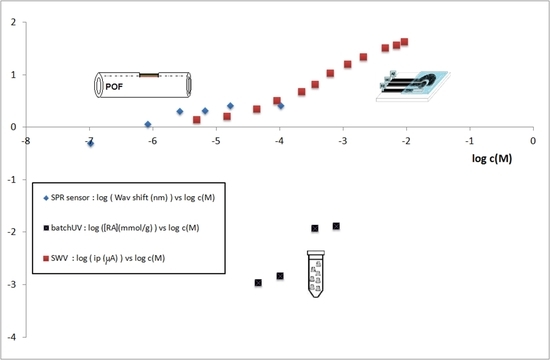Sensing by Molecularly Imprinted Polymer: Evaluation of the Binding Properties with Different Techniques
Abstract
:1. Introduction
2. Materials and Methods
2.1. Reagents and Materials
2.2. Prepolymeric Mixture
2.3. Preparation of MIP Particles
2.4. Preparation of the Polymer-Modified Electrochemical Cell
2.5. Preparation of the Polymer-Modified SPR Platform
2.6. Experimental Methods for Binding Investigation
2.6.1. UV Determination for Batch Equilibration
- 5-Hydroxymethyl-2-furaldehyde (HMF) at λ = 286 nm: A286 = 1.890(2) × 104 c + 0.001(1) (LOD = 1.6 × 10−7 M).
- Furfuryl alcohol (FA) at λ = 217 nm: A217 = 0.992(2) × 104 c + 0.003(9) (LOD = 3.0 × 10−7 M).
2.6.2. Batch Equilibration
2.6.3. Voltammetric Determination
2.6.4. SPR Determination
2.7. Evaluation of the Binding Parameters of 2-FAL on MIP
2.7.1. Binding Parameters by Batch Equilibration
2.7.2. Binding Parameters by Sensors
3. Results
3.1. Binding of 2-FAL to MIP by Batch Equilibration
3.2. Investigation of the Binding of 2-FAL to MIP by the Electrochemical SPC-MIP Sensor
3.3. Investigation of the Binding of 2-FAL to MIP by an SPR Sensor
4. Discussion
5. Conclusions
Supplementary Materials
Author Contributions
Funding
Conflicts of Interest
References
- Homola, J. Present and future of surface plasmon resonance biosensors. Anal. Bioanal. Chem. 2003, 377, 528–539. [Google Scholar] [CrossRef]
- Olaru, A.; Bala, C.; Jaffrezic-Renault, N.; Aboul-Enein, H.Y. Surface plasmon resonance (SPR) biosensors in pharmaceutical analysis. Crit. Rev. Anal. Chem. 2015, 45, 97–105. [Google Scholar] [CrossRef]
- Gonçalves, A.M.; Pedro, A.Q.; Santos, F.M.; Martins, L.M.; Maia, C.J.; Queiroz, J.A.; Passarinha, L.A. Trends in protein-based biosensor assemblies for drug screening and pharmaceutical kinetic studies. Molecules 2014, 19, 12461–12485. [Google Scholar] [CrossRef] [PubMed]
- Altintas, Z.; Guerreiro, A.; Piletsky, S.A.; Tothill, I.E. Nano MIP based optical sensor for pharmaceuticals monitoring. Sens. Actuat. B Chem. 2015, 213, 305–313. [Google Scholar] [CrossRef]
- Munoz, E.M.; Correa, J.; Riguera, R.; Fernandez-Megia, E. Real-time evaluation of binding mechanisms in multivalent interactions: A surface plasmon resonance kinetic approach. J. Am. Chem. Soc. 2013, 135, 5966–5969. [Google Scholar] [CrossRef] [PubMed]
- Wijaya, E.; Lenaerts, C.; Maricot, S.; Hastanin, J.; Habraken, S.; Vilcot, J.-P.; Boukherroub, R.; Szunerits, S. Surface plasmon resonance-based biosensors: From the development of different SPR structures to novel surface functionalization strategies. Curr. Opin. Solid State Mater. Sci. 2011, 15, 208–224. [Google Scholar] [CrossRef]
- Cooper, M.A. Optical biosensors in drug discovery. Nat. Rev. Drug Discov. 2002, 1, 515–528. [Google Scholar] [CrossRef] [PubMed]
- Uludag, Y.; Tothill, I.E. Cancer biomarker detection in serum samples using surface plasmon resonance and quartz crystal microbalance sensors with nanoparticle signal amplification. Anal. Chem. 2012, 84, 5898–5904. [Google Scholar] [CrossRef]
- Henry, O.Y.; Cullen, D.C.; Piletsky, S.A. Optical interrogation of molecularly imprinted polymers and development of MIP sensors: A review. Anal. Bioanal. Chem. 2005, 382, 947–956. [Google Scholar] [CrossRef]
- Caucheteur, C.; Guo, T.; Albert, J. Review of plasmonic fiber optical chemical sensors: Improving the limit of detection. Anal. Bioanal. Chem. 2015, 407, 3883–3897. [Google Scholar] [CrossRef]
- Cennamo, N.; Massarotti, D.; Conte, L.; Zeni, L. Low cost sensors based on SPR in a plastic optical fiber for biosensor implementation. Sensors 2011, 11, 11752–11760. [Google Scholar] [CrossRef] [PubMed]
- Cennamo, N.; de Maria, L.; D’Agostino, G.; Zeni, L.; Pesavento, M. Monitoring of low levels of furfural in power transformer oil with a sensor system based on a POF-MIP platform. Sensors 2015, 15, 8499–8511. [Google Scholar] [CrossRef]
- Cennamo, N.; D’Agostino, G.; Galatus, R.; Bibbò, L.; Pesavento, M.; Zeni, L. Sensors based on surface plasmon resonance in a plastic optical fiber for the detection of trinitrotoluene. Sens. Actuators B Chem. 2013, 188, 221–226. [Google Scholar] [CrossRef]
- Sellergren, B. Noncovalent molecular imprinting: Antibody-like molecular recognition in polymeric network materials. Trends Anal. Chem. 1997, 16, 310–320. [Google Scholar] [CrossRef]
- Mayes, A.G.; Mosbach, K. Molecularly imprinted polymers: Useful materials for analytical chemistry? Trend Anal. Chem. 1997, 16, 321–332. [Google Scholar] [CrossRef]
- Haupt, K.; Mosbach, K. Molecularly imprinted polymers and their use in biomimetic sensors. Chem. Rev. 2000, 100, 2495–2504. [Google Scholar] [CrossRef] [PubMed]
- Runfa, L.; Yonghai, F.; Guoqing, P.; Lei, L. Advances in molecularly imprinting technology for bioanalytical applications. Sensors 2019, 19, 177–211. [Google Scholar]
- Beyazit, S.; Tse Sum Bui, B.; Haupt, K.; Gonzato, C. Molecularly imprinted polymer nanomaterials and nanocomposites by controlled/living radical polymerization. Prog. Polym. Sci. 2016, 62, 1–21. [Google Scholar] [CrossRef]
- Umpleby, R.J., II; Baxter, S.C.; Chen, Y.; Shah, R.N.; Shimizu, K.D. Characterization of molecularly imprinted polymers with the Langmuir-Freundlich isotherm. Anal. Chem. 2001, 73, 4584–4591. [Google Scholar] [CrossRef]
- Schauperl, M.; Lewis, D.W. Probing the structural and binding mechanism heterogeneity of molecularly imprinted polymers. J. Phys. Chem. B 2015, 119, 563–571. [Google Scholar] [CrossRef]
- Sellergren, B.; Shea, K.J. Origin of peak asymmetry and the effect of temperature on solute retention in enantiomer separations on imprinted chiral stationary phases. J. Chromatogr. A 1995, 690, 29–30. [Google Scholar] [CrossRef]
- Charmas, B.; Leboda, R. Effect of surface heterogeneity on adsorption on solid surfaces application of inverse gas chromatography in the studies of energetic heterogeneity of adsorbents. J. Chromatogr. A 2000, 886, 133–152. [Google Scholar] [CrossRef]
- Vijayendran, R.A.; Leckband, D.E. A quantitative assessment of heterogeneity for surface-immobilized proteins. Anal. Chem. 2001, 73, 471–480. [Google Scholar] [CrossRef]
- Shea, K.J.; Spivak, D.A.; Sellergren, B. Polymer complements to nucleotide bases. Selective binding of adenine derivatives to imprinted polymers. J. Am. Chem. Soc. 1993, 115, 3368–3369. [Google Scholar]
- Andersson, L.; Muller, R.; Vlatakis, G.; Mosbach, K. Mimics of the binding sites of opioid receptors obtained by molecular imprinting of enkephalin and morphine. Proc. Natl. Acad. Sci. USA 1995, 92, 4788–4792. [Google Scholar] [CrossRef]
- Vlatakis, G.; Andersson, L.I.; Muller, R.; Mosbach, K. Drug assay using antibody mimics made by molecular imprinting. Nature 1993, 361, 645–647. [Google Scholar] [CrossRef]
- Sajonz, P.; Kele, M.; Zhong, G.M.; Sellergren, B.; Guiochon, G. Study of the thermodynamics and mass transfer kinetics of two enantiomers on a polymeric imprinted stationary phase. J. Chromatogr. A 1998, 810, 1–17. [Google Scholar] [CrossRef]
- Umpleby, R.J., II; Baxter, S.C.; Bode, M.; Berch, J.K., Jr.; Shah, R.N.; Shimizu, K.D. Application of the Freundlich adsorption isotherm in the characterization of molecularly imprinted polymers. Anal. Chim. Acta 2001, 435, 35–42. [Google Scholar] [CrossRef]
- Umpleby, R.J., II; Baxter, S.C.; Rampey, A.M.; Rushton, G.T.; Chen, Y.; Shimizu, K.D. Characterization of the heterogeneous binding site affinity distributions in molecularly imprinted polymers. J. Chromatogr. B 2004, 804, 141–149. [Google Scholar] [CrossRef]
- Garcia-Calzon, J.A.; Diaz-Garcia, M.E. Characterization of binding sites in molecularly imprinted polymers. Sensor Actuators B Chem. 2007, 123, 1180–1194. [Google Scholar] [CrossRef]
- Hu, Q.; Wang, Q.; Feng, C.; Zhang, Z.; Lei, Z.; Shimizu, K. Insights into mathematical characteristics of adsorption models and physical meaning of corresponding parameters. J. Mol. Liquids 2018, 254, 20–25. [Google Scholar] [CrossRef]
- Musile, G.; Cenci, L.; Andreetto, E.; Ambrosi, E.; Tagliaro, F.; Bossi, A.M. Screening of the binding properties of molecularly imprinted nanoparticles via capillary electrophoresis. Anal. Bioanal. Chem. 2016, 408, 3435–3443. [Google Scholar] [CrossRef] [PubMed]
- Blanco-Lopez, M.C.; Lobo-Castanon, M.J.; Miranda-Ordieres, A.J.; Tunon-Blanco, P. Electrochemical sensors based on molecularly imprinted polymers. Trend Anal. Chem. 2004, 23, 36–48. [Google Scholar] [CrossRef]
- Alizadeh, T.; Azizi, S. Graphene/graphite paste electrode incorporated with molecularly imprinted polymer nanoparticles as a novel sensor for differential pulse voltammetry determination of fluoxetine. Biosens. Bioelectron. 2016, 81, 198–206. [Google Scholar] [CrossRef] [PubMed]
- Adumitrăchioaie, A.; Tertiș, M.; Cernat, A.; Săndulescu, R.; Cristea, C. Electrochemical methods based on molecularly imprinted polymers for drug detection. A review. Int. J. Electrochem. Sci. 2018, 13, 2556–2576. [Google Scholar] [CrossRef]
- Pesavento, M.; D’Agostino, G.; Alberti, G.; Biesuz, R.; Merli, D. Voltammetric platform for detection of 2,4,6-trinitrotoluene based on a molecularly imprinted polymer. Anal. Bioanal. Chem. 2013, 405, 3559–3570. [Google Scholar] [CrossRef] [PubMed]
- Pesavento, M.; D’Agostino, G.; Biesuz, R.; Alberti, G.; Profumo, A. Ion selective electrode for dopamine based on a molecularly imprinted polymer. Electroanalysis 2011, 24, 813–824. [Google Scholar] [CrossRef]
- D’Agostino, G.; Alberti, G.; Biesuz, R.; Pesavento, M. Potentiometric sensor for atrazine based on a molecular imprinted membrane. Biosens. Bioelectron. 2006, 15, 145–152. [Google Scholar] [CrossRef]
- Shamsipur, M.; Beigi, A.A.M.; Teymouri, M.; Tash, S.A.; Samimi, V. Electrocatalytic application of girard’s reagent t to simultaneous determination of furaldehydes in pharmaceutical and food matrices by highly sensitive voltammetric methods. Electroanalysis 2010, 22, 1314–1322. [Google Scholar] [CrossRef]
- Baggiani, C.; Giovannoli, C.; Anfossi, L.; Passini, C.; Baravalle, P.; Giraudi, G. A connection between the binding properties of imprinted and nonimprinted polymers: a change of perspective in molecular imprinting. J. Am. Chem. Soc. 2012, 134, 1513–1518. [Google Scholar] [CrossRef]
- Matsui, J.; Miyoshi, Y.; Doblhoff-Dier, O.; Takeuchi, T. A molecularly imprinted synthetic polymer receptor selective for atrazine. Anal. Chem. 1995, 67, 4404–4408. [Google Scholar] [CrossRef]
- Puziy, A.M.; Matynia, T.; Gawdzik, B.; Poddubnaya, O.I. Use of CONTIN for calculation of adsorption energy distribution. Langmuir 1999, 15, 6016–6025. [Google Scholar] [CrossRef]

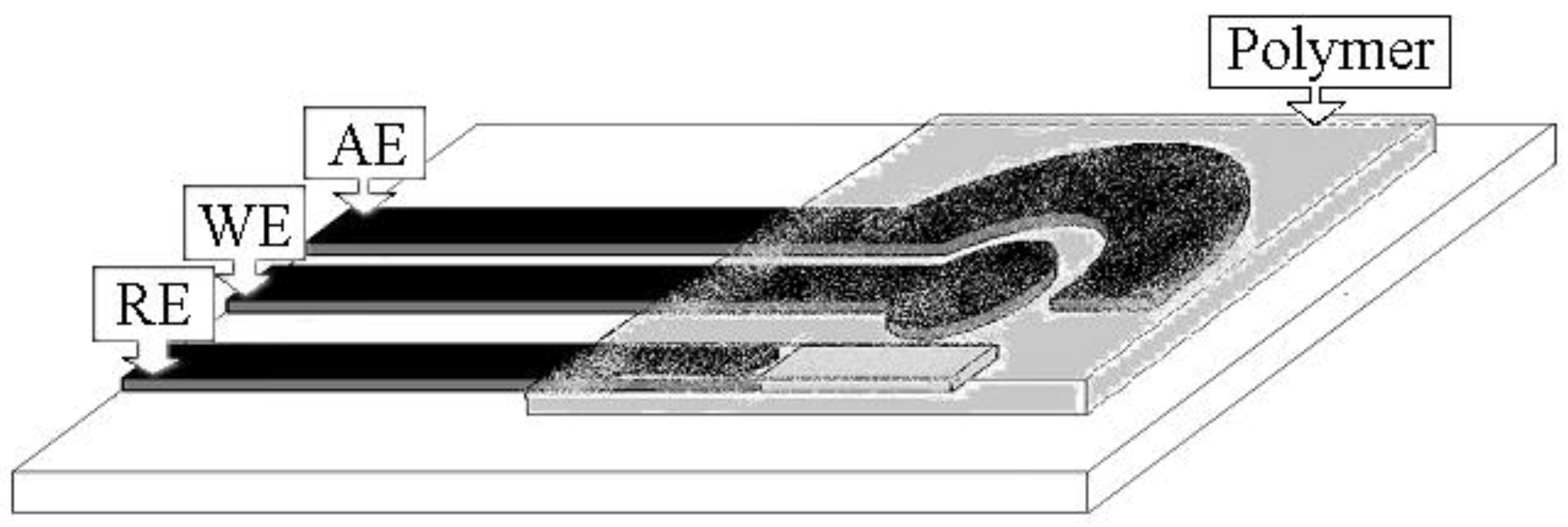
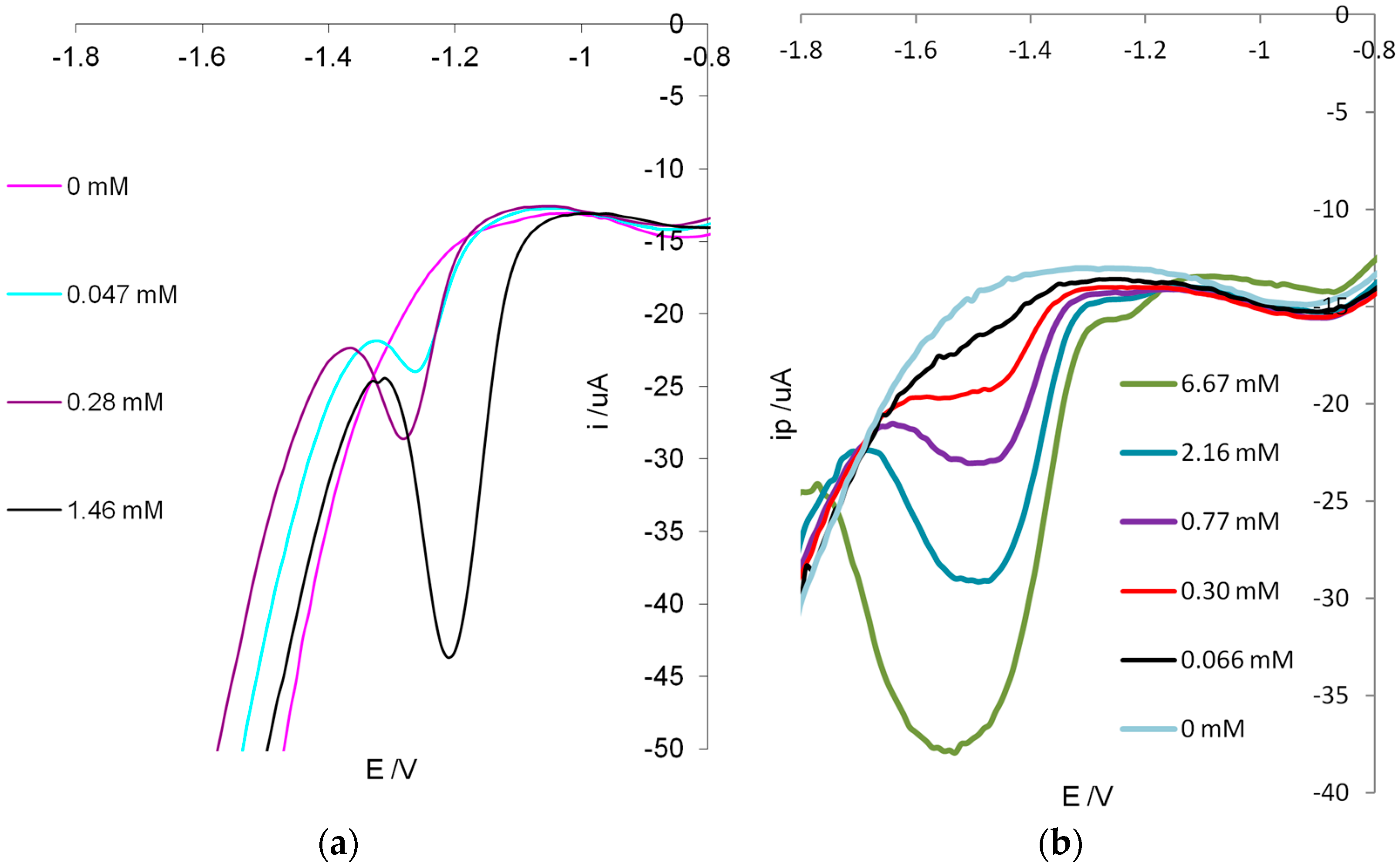

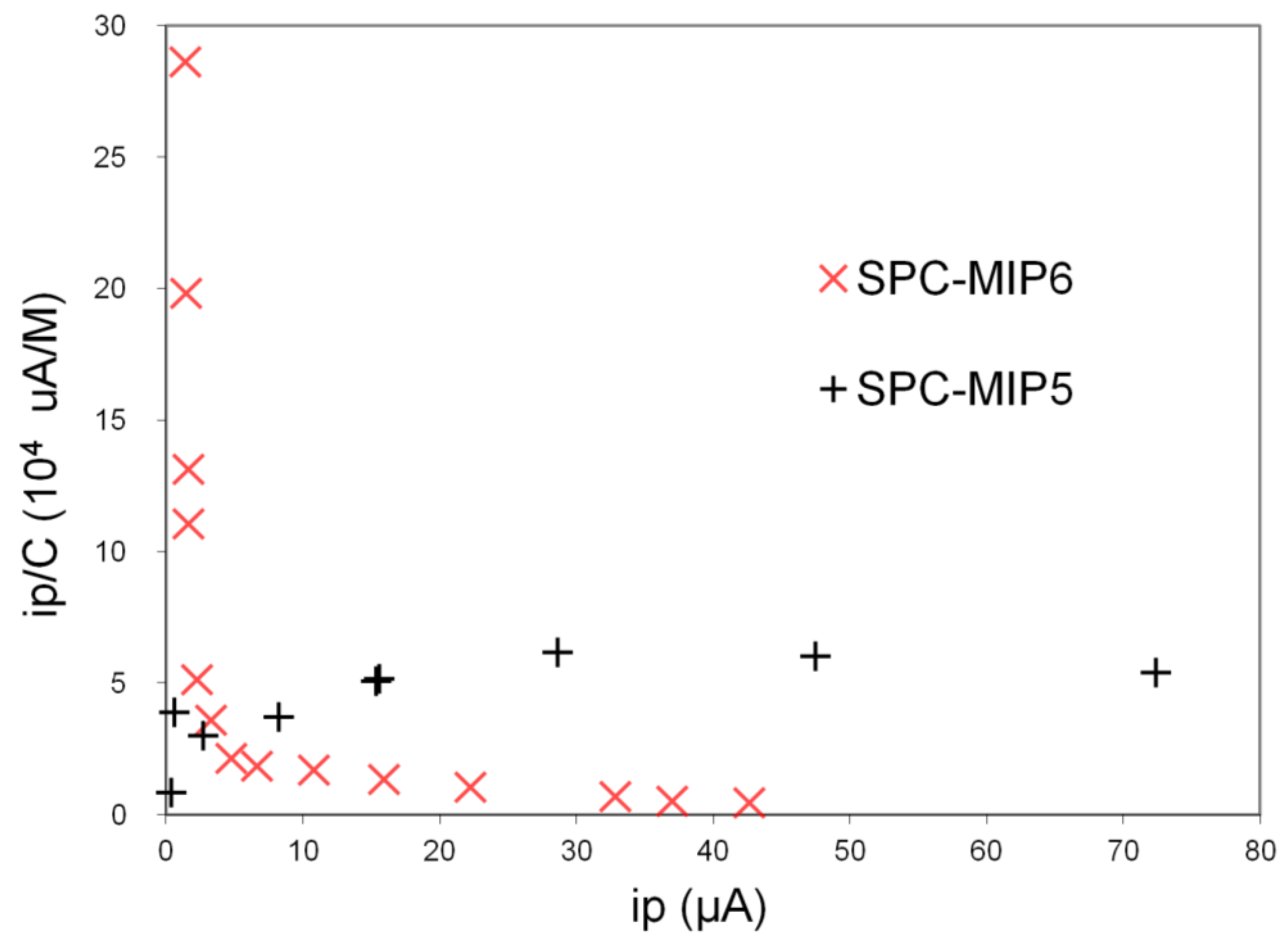

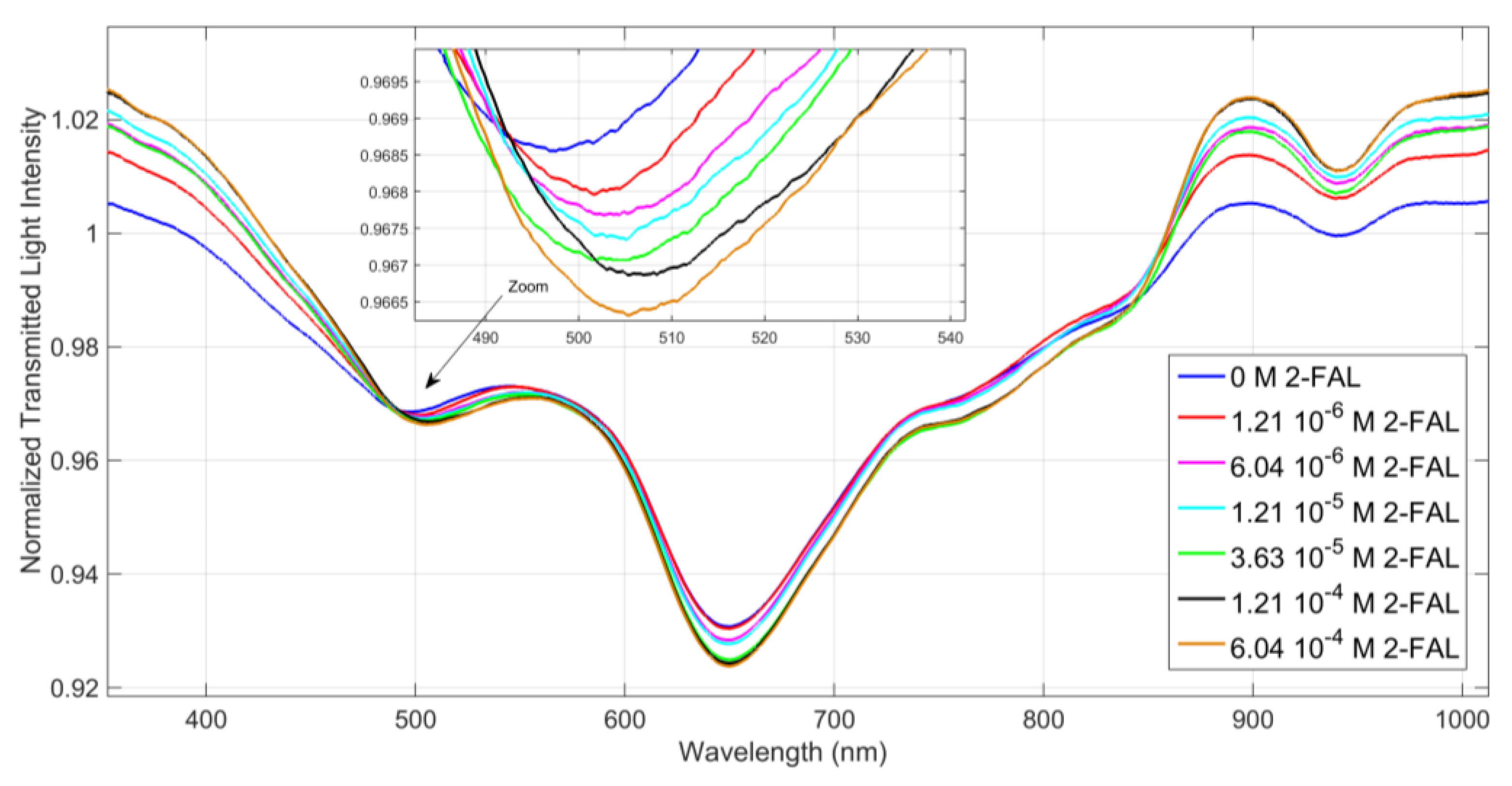

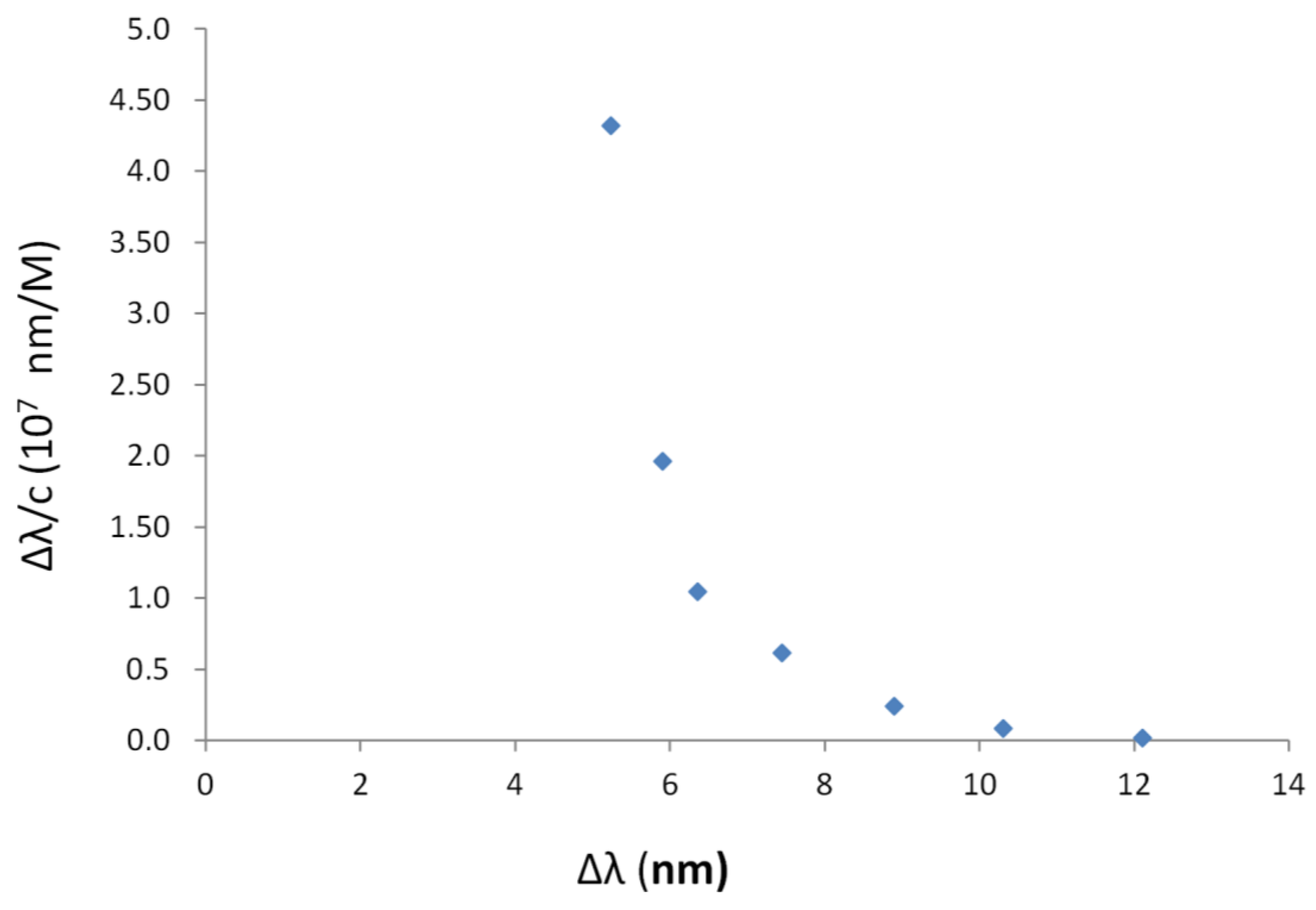

| KA (M−1) | kcR (μA) | Sensitivity (μA/M) at Low Concentration | LOD (M) 1 | |
|---|---|---|---|---|
| Site with high affinity (sites 2) | 2(1) × 105 | 2(2) | 6(2) × 105 | 7.6 × 10−7 |
| Sites with low affinity (sites 1) | 3.1(9) × 102 | 51(1) | 1.60(2) ×104 |
| KA (M−1) | kcR (nm) | Sensitivity at Low Concentration (nm/M) | LOD (M)1 | |
|---|---|---|---|---|
| Sites at high affinity (sites 3) (c up to 6 10−7 M) | 3.0(4) 107 | 7(2) | 2.0(2) 108 | 5 × 10−9 |
| Sites at low affinity (sites 2) (c =3-60 10−6 M) | 1.7(2) 105 | 6(1) | 9.7(6) 105 |
© 2019 by the authors. Licensee MDPI, Basel, Switzerland. This article is an open access article distributed under the terms and conditions of the Creative Commons Attribution (CC BY) license (http://creativecommons.org/licenses/by/4.0/).
Share and Cite
Pesavento, M.; Marchetti, S.; De Maria, L.; Zeni, L.; Cennamo, N. Sensing by Molecularly Imprinted Polymer: Evaluation of the Binding Properties with Different Techniques. Sensors 2019, 19, 1344. https://doi.org/10.3390/s19061344
Pesavento M, Marchetti S, De Maria L, Zeni L, Cennamo N. Sensing by Molecularly Imprinted Polymer: Evaluation of the Binding Properties with Different Techniques. Sensors. 2019; 19(6):1344. https://doi.org/10.3390/s19061344
Chicago/Turabian StylePesavento, Maria, Simone Marchetti, Letizia De Maria, Luigi Zeni, and Nunzio Cennamo. 2019. "Sensing by Molecularly Imprinted Polymer: Evaluation of the Binding Properties with Different Techniques" Sensors 19, no. 6: 1344. https://doi.org/10.3390/s19061344
APA StylePesavento, M., Marchetti, S., De Maria, L., Zeni, L., & Cennamo, N. (2019). Sensing by Molecularly Imprinted Polymer: Evaluation of the Binding Properties with Different Techniques. Sensors, 19(6), 1344. https://doi.org/10.3390/s19061344






